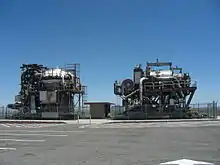WS-125
The WS-125 was an American super long-range strategic bomber project during the Cold War to develop a nuclear-powered aircraft, which was scheduled to be designated the B-72.
| WS-125 | |
|---|---|
| Project for | Long-range Nuclear-powered aircraft strategic bomber |
| Requirement | WS-125 |
| Issued by | United States Air Force |


In 1954, the United States Air Force (USAF) issued a weapons system requirement for a nuclear-powered bomber, designated WS-125. In 1956, GE teamed up with Convair (X211 program) and Pratt & Whitney with Lockheed in competitive engine/airframe development to address the requirement.
In 1956, the USAF decided that the proposed WS-125 bomber was unfeasible as an operational strategic aircraft. Finally, after spending more than $1 billion, the project was canceled on March 28, 1961.
Powerplants
Two General Electric J87 turbofan engines were successfully powered to nearly full thrust using two shielded reactors. Two experimental engines complete with reactor systems (HTRE-3 and HTRE-1, which was modified and renamed HTRE-2) are currently located at the EBR-1 facility south of the Idaho National Laboratory 43°30′42.22″N 113°0′18″W.
See also
- 9M730 Burevestnik (Russia)
- Planes That Never Flew, Discovery Channel
- Project Pluto – US nuclear ramjet project, 1957-1964
- Convair NB-36H
- Convair X-6 – Proposed experimental aircraft project to test nuclear powered flight, never built
References
- Butler, Tony (2010). American Secret Projects. Hinckley, England: Midland Publishing. ISBN 978-1-85780-331-0.